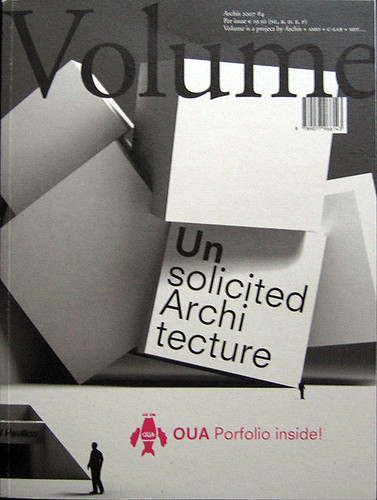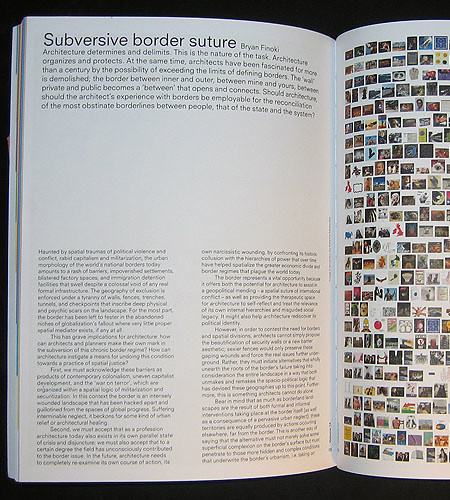Volume : OUA : Subtopia
Volume magazine just released its 14th issue dedicated to establishing a new speculative Office for Unsolicited Architecture, where architects take a more pro-active role as initiators and doers of change and landscape address, rather than just being content to sit back as reactive service industrialites.
Actually, it’s about exploring how we can bridge the two – the commercial and financial sustainability of a typical practice with the more responsible and rugged pursuit of affecting the environment from the periphery.

Ole Bouman writes -
I love the idea, of architects seeking out the lesser obvious informal niches of spatial neglect to apply themselves, and to examine their own relevancy in terms of taking new risks and finding ways of offering their skills without waiting for some form of consent, without worrying about the AIA’s stamp of approval.
In fact, it is quite literally about turning the AIA and establishment upside down on its head and re-inventing a new body of organizers and activists, a new social and political agency to represent architecture as it should be.
While this notion isn't groundbreakingly new, since there are voices out there who have been critical and suggestive like this for years, and other architects out there who have been fulfilling this role for years as well, (and, probably, deep down in their soul of souls every architect would respond this way to the architectural dilemma), I love it for being radical in such a sensible way. It’s needed guerilla; it’s noble outlaw; it’s unflappably humanitarian; it’s fed up! It’s a call to arms; it’s a time to roll up the sleeves and DO the kinds of projects you ultimately want to and that ultimately NEED doing; it’s a critical reflection on self in the face of an architectural gap; it’s restless, hungry, it's ready…
And, it’s a cool issue! -- with some funky proposals, like the one to turn the San Francisco Golden Gate Bridge into a floating columbarium; a kind of joint barrier / cemetery / crematorium / memorial for the suicidal souls who have, sadly -- or would sadly plan -- to jump off the world’s most popular suicide magnet.
Or a schematic, which I hope to refer to later in a future post when I get time, that would allow the residents of Lebanon to voluntary dismantle their civil infrastructure (like highways and bridges) to somehow repurpose them along a strategic coastal linear network of refugee evacuation barges, so that the city is in a sense not only spared the prospect of future military destruction but it also becomes the vehicle for safely retreating from their mainland and to join together again in a massive floatilla of interconnected barges. A crazy crazy prospect, still not totally sure of how it is supposed to work, but it is referred to as Offshore Urbanism, and I love it.

And, best part of the issue for me is that I actually have an article of my own in there, called Subversive Border Suture, that tries to help figure how architects can interface with border zones in an informal and transcendent sort of way. Here’s an extract:
The article goes on for another page and a half more than pictured above, and offers a little survey of some different projects that I see as pioneering a kind of geopolitical spatial mending, most of which I have mentioned here on Subtopia at some point, or another.
Anyway, if you happen to get your hands on a copy, check it out – super cool issue. And if you want to get your hands on a copy, you can order one (or as many as you like!) from the Archis website right here.
Actually, it’s about exploring how we can bridge the two – the commercial and financial sustainability of a typical practice with the more responsible and rugged pursuit of affecting the environment from the periphery.

Ole Bouman writes -
Architecture, whether designed by agents in the real estate market or the small elite of star architects, is giving up its utopian impulse only to become a modest player among many in the average building process. Architects as demiurges, geniuses or saviors who didn’t really die in a heroic struggle. No, they just became outdated. Even death has been taken away from them.
The good news is: if the architect is still alive, s/he can only start living independently again and stop acting as either slave or clown. For instance: why not act as an initiator by exploring all those opportunities to which architecture can come to rescue, but nobody has thought of yet? If the architect turns out to me immortal, why not revive the role attributed to hi in the first place: to organize our spaces intelligently.
If professional choice in recent decades has been reduced to either becoming a passive facilitator or a court jester with special permission to do weird things every now and then, perhaps the time has come to no longer respond to others’ questions and expectations but to pose them yourself, perhaps the time has come to design not as a solicited by a client, site or available budget, but to design unsolicited architecture, and find sites, budgets and client for it.
I love the idea, of architects seeking out the lesser obvious informal niches of spatial neglect to apply themselves, and to examine their own relevancy in terms of taking new risks and finding ways of offering their skills without waiting for some form of consent, without worrying about the AIA’s stamp of approval.
In fact, it is quite literally about turning the AIA and establishment upside down on its head and re-inventing a new body of organizers and activists, a new social and political agency to represent architecture as it should be.
While this notion isn't groundbreakingly new, since there are voices out there who have been critical and suggestive like this for years, and other architects out there who have been fulfilling this role for years as well, (and, probably, deep down in their soul of souls every architect would respond this way to the architectural dilemma), I love it for being radical in such a sensible way. It’s needed guerilla; it’s noble outlaw; it’s unflappably humanitarian; it’s fed up! It’s a call to arms; it’s a time to roll up the sleeves and DO the kinds of projects you ultimately want to and that ultimately NEED doing; it’s a critical reflection on self in the face of an architectural gap; it’s restless, hungry, it's ready…
And, it’s a cool issue! -- with some funky proposals, like the one to turn the San Francisco Golden Gate Bridge into a floating columbarium; a kind of joint barrier / cemetery / crematorium / memorial for the suicidal souls who have, sadly -- or would sadly plan -- to jump off the world’s most popular suicide magnet.
Or a schematic, which I hope to refer to later in a future post when I get time, that would allow the residents of Lebanon to voluntary dismantle their civil infrastructure (like highways and bridges) to somehow repurpose them along a strategic coastal linear network of refugee evacuation barges, so that the city is in a sense not only spared the prospect of future military destruction but it also becomes the vehicle for safely retreating from their mainland and to join together again in a massive floatilla of interconnected barges. A crazy crazy prospect, still not totally sure of how it is supposed to work, but it is referred to as Offshore Urbanism, and I love it.

And, best part of the issue for me is that I actually have an article of my own in there, called Subversive Border Suture, that tries to help figure how architects can interface with border zones in an informal and transcendent sort of way. Here’s an extract:
Haunted by spatial traumas of political violence and conflict, rabid capitalism and militarization, the urban morphology of the world's national borders today amounts to a rash of barriers, impoverished settlements, blistered factory spaces, and immigration detention facilities that swell despite a colossal void of any real formal infrastructure. The geography of exclusion is enforced under a tyranny of walls, fences, trenches, tunnels, and checkpoints that inscribe deep physical and psychic scars on the landscape. For the most part, the border has been left to fester in the abandoned niches of globalization's fallout where very little proper spatial mediator exists, if any at all.
This has grave implications for architecture: how can architects and planners make their own mark in the subversion of this chronic border regime? How can architecture instigate a means for undoing this condition towards a practice of spatial justice?
First, we must acknowledge these barriers as products of contemporary colonialism, uneven capitalist development, and the 'war on terror', which are organized within a spatial logic of militarization and securitization. In this context the border is an intensely wounded landscape that has been hacked apart and guillotined from the spaces of global progress. Suffering interminable neglect, it beckons for some kind of urban relief or architectural healing.
Second, we must accept that as a profession architecture today also exists in its own parallel state of crisis and disjuncture; we must also accept that to a certain degree the field has unconsciously contributed to the border issue. In the future, architecture needs to completely re-examine its own course of action, its own narcissistic wounding, by confronting its historic collusion with the hierarchies of power that over time have helped spatialize the greater economic divide and border regimes that plague the world today.
The border represents a vital opportunity because it offers both the potential for architecture to assist in a geopolitical mending – a spatial suture of international conflict – as well as providing the therapeutic space for architecture to self-reflect and treat the relevance of its own internal hierarchies and misguided social legacy. It might also help architecture rediscover its political identity.
The article goes on for another page and a half more than pictured above, and offers a little survey of some different projects that I see as pioneering a kind of geopolitical spatial mending, most of which I have mentioned here on Subtopia at some point, or another.
Anyway, if you happen to get your hands on a copy, check it out – super cool issue. And if you want to get your hands on a copy, you can order one (or as many as you like!) from the Archis website right here.







2 Comments:
Nothing to do with Volume OUA but might interest you:
Artivists and Mobile Phones: The Transborder Immigrant Project
http://mobileactive.org/artivists-and-mobile-pho
Bernard
(From http://lingni-net.blogspot.com/)
bernard
thanks, i've actually seen that, but always good to reminded!
b
Post a Comment
<< Home